It’s not unusual to come across some really alien-like lifeforms while investigating the deep ocean, but every now and then scientists come across something genuinely amazing. Researchers at the Monterey Bay Aquarium Research Institute (MBARI) recently made such an observation, capturing on video something they’ve only seen four times in over three decades of deep-sea research: a high fin dragonfish. Senior Scientist at MBARI Bruce Robison and colleagues on board the research vessel Western Flyer spotted the extremely unusual species. The high fin dragonfish (Bathophilus flemingi) was gliding through the seas of California at a depth of roughly 300 meters (980 ft), just outside of Monterey Bay.
One YouTube user characterized the metallic fish as “like a small bronze submarine” or a “deep-sea Toblerone,” as IFLScience’s Managing Editor Katy Evans put it. When not on camera and in its native habitat, it is likely to appear substantially different. “These fish exist in either weak light or complete darkness, with just bioluminescence for illumination,” Robison told IFLScience. “As a result, their natural look is nothing like what we see in these films.”
“Many other fishes have silvery sides that reflect ambient light, allowing them to blend in aesthetically. Bathophilus’ skin’s metallic appearance serves a similar purpose. In terms of hue, the examples I’ve seen have a wide range. Some, like this one, were bronze, while others were copper, brass, or even shiny green. They might be able to change the hue to fit the situation, or they might not; we don’t know yet.” While its position may appear odd, it is part of dragonfishes’ predation strategy, which involves them hanging still in the water until prey comes within reach. With their enormous, toothy jaws, they chomp down on whatever unfortunate animal came within chewing reach.
Bathophilus is shrouded in mystery due to its elusiveness, but we do know that it shares the water column with a diverse range of species, including squids, crabs, and worms, as well as certain predatory marine animals. Robison noted, “Anything bigger than this fish is a possible predator.” “They live in a perilous world.” The researchers hope that this rare snippet of footage will help them better understand highfin dragonfish by being used in a variety of ongoing studies on topics such as prey attraction behavior, deep-sea fish behavioral pigmentation pattern changes, and the impact of climate change on marine communities at this depth. “You never know how an accidental observation like this will pay off,” Robison said, “but they almost always do.”
















